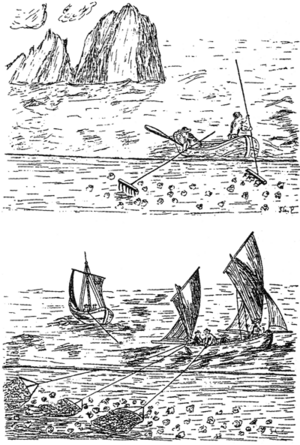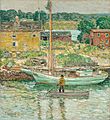Fishing dredge facts for kids
A fishing dredge is a special tool used by fishermen to collect seafood from the bottom of the sea. It's like a big scoop or net that a fishing boat pulls along the seabed. People often call it a scallop dredge or an oyster dredge because it's commonly used to gather scallops and oysters. It can also catch other shellfish like clams, crabs, and even sea cucumbers. Once the dredge is full, fishermen lift it onto the boat and empty their catch.

Contents
How Fishing Dredges Work
A fishing dredge is designed to scrape the seabed. It collects animals living on or just under the sand and mud.
Different Types of Dredges
Some older dredges, especially in Europe, had "teeth" at the bottom. These teeth are called tynes. They would rake or plough through the sand and mud. This helped to dig up buried clams and other shellfish. However, some modern dredges, like those from New Bedford in the USA, do not have these teeth.
The Net Part
The net part of a dredge has large holes, called a "gross mesh." This is important because it lets smaller sea creatures pass through. Only the larger animals, like the scallops or oysters that fishermen want to catch, get trapped. Sometimes, the net also catches animals that eat scallops, such as whelks, starfish, and octopus.
How Many Dredges Can a Boat Pull?
Fishing boats can pull several dredges at once. Sometimes, three or four dredges are connected to a strong, wheeled bar. Many of these bars can be towed from a very heavy spreading bar. Usually, one spreading bar is on each side of the ship.
The number of dredges a boat can pull depends on how powerful the ship is. It also depends on how much space there is on the side of the boat for the crew to work. A small 10-meter boat might pull three dredges on each side. A larger 30-meter ship with 1500 hp might pull up to 20 dredges on each side!
Impact on the Seabed
When many heavy dredges are pulled along the seabed, they can dig up the ground. They can overturn rocks and crush plants and animals in their path. This can sometimes damage the seabed if not done carefully.
Challenges with Dredging
One common issue is that scallops caught by dredges often contain sand. Also, as mentioned, careless dredging can harm the seabed. Because of these concerns, some fishermen are now using other methods. For example, scuba diving is sometimes used to collect scallops instead of dredging.
However, inventors are always working to create better dredges. They want to design dredges that are more efficient and cause less harm to the ocean floor.
-
Mussel dredgers
-
Fishing ship with a benthic dredge, leaving the port of Nieuwpoort
-
Oyster Boats North River, by John Henry Twachtman (1853–1902)
-
Dredging For Oysters, by Alexander Rummler. WPA mural.
Related pages








